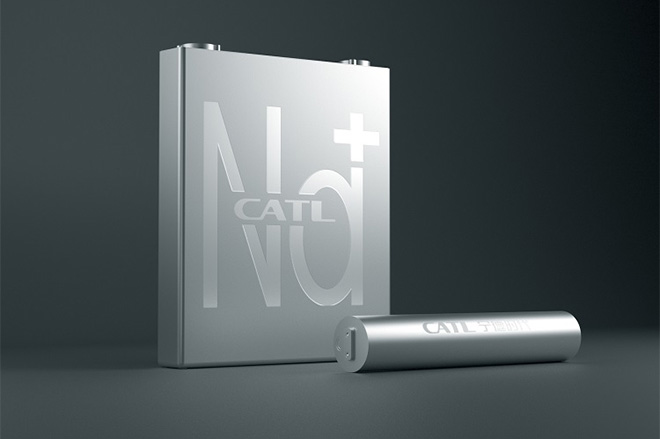Sodium-ion batteries, which could offer significant cost and raw material procurement advantages over the lithium-ion kind, have been much discussed in the press of late.
Chinese battery behemoth CATL unveiled its first-generation sodium-ion battery in July 2021. At the time, analysts predicted that Na-ion cells, which are expected to offer only modest energy density, would find their main applications in energy storage and two-wheeled EVs.
Now CATL has revealed that Chinese automaker Chery, which specializes in low-cost subcompact cars, will be the first customer to use CATL’s sodium-ion batteries in a production vehicle. Neither company has yet offered any details.
Back in 2021, CATL said that it would build a sodium-ion battery supply chain by 2023, and that specific energy of the cells would exceed 200 Wh/kg—enough to meet the needs of EVs with a range of up to 400 km.
CATL has proposed a mixed battery pack that leverages both the higher energy density of Li-ion cells and Na-ion’s benefits in terms of cost, fast charging and low-temperature performance. Is that what the upcoming Chery model will use?
CATL isn’t the only player in the sodium sandbox. In February, Hina Battery unveiled three sodium-ion battery cell types, and announced a partnership with automaker JAC, which has reportedly built a test vehicle using Na-ion cells. In March, Farasis Energy said it would supply Na-ion cells to carmaker JMEV.
Last November, BYD, the world’s largest EV-maker, said that it would start mass production of sodium-ion batteries in Q2 2023, and deploy them in three models: the Qin, the Dolphin, and the newly launched Seagull.
The latter is on display at the Shanghai Auto Show, and is attracting much attention for its impossibly low starting price of 78,000 yuan ($11,300). However, BYD says it is equipped with a lithium iron phosphate BYD Blade battery—at least for now.
When will sodium-ion cells appear in a production vehicle, and who will be building it? We await the answers, but we do know one thing: this particular bit of EV history will be made in China.
Sources: CnEVPost via Electrive, CarNewsChina

lasuna order – cheap lasuna pill himcolin pill
gabapentin drug – sulfasalazine 500mg price cost sulfasalazine 500mg
purchase besivance sale – order besivance online cheap buy cheap generic sildamax
celecoxib over the counter – cheap urispas tablets where to buy indocin without a prescription
buy generic benemid 500 mg – order monograph generic order carbamazepine pill
order diclofenac generic – order aspirin online cheap aspirin 75mg sale
cheap mebeverine 135mg – cost etoricoxib 120mg cilostazol pills
purchase mestinon generic – buy imitrex 50mg generic buy generic azathioprine
order rumalaya without prescription – order endep 10mg generic order elavil online
order lioresal – baclofen 10mg pills buy feldene 20mg online
purchase voveran generic – diclofenac for sale nimotop generic
order generic periactin – buy tizanidine 2mg buy generic zanaflex
order meloxicam generic – cost toradol buy ketorolac pill
order cefdinir 300 mg for sale – purchase cefdinir without prescription buy generic clindamycin over the counter
how to buy trihexyphenidyl – order cheap diclofenac gel buy emulgel for sale
buy deltasone 20mg pills – purchase permethrin sale zovirax for sale
cheap isotretinoin 40mg – buy deltasone 10mg generic deltasone ca
purchase betnovate for sale – buy adapalene online order monobenzone without prescription
acticin sale – buy permethrin without a prescription oral retin
order flagyl 400mg generic – where can i buy flagyl cenforce where to buy
amoxiclav sale – buy amoxiclav buy levoxyl tablets
order cozaar sale – buy losartan 50mg pills cost keflex 500mg
purchase cleocin online cheap – order indocin 50mg online order indocin pills
buy provigil medication – buy generic meloset online meloset pills
crotamiton usa – purchase mupirocin without prescription buy aczone pills for sale
zyban 150mg over the counter – buy bupropion 150 mg online cheap shuddha guggulu without prescription
buy capecitabine 500mg pills – order naproxen 250mg pill danocrine 100mg sale
order alendronate pills – fosamax 70mg price buy provera 5mg generic
purchase aygestin sale – how to buy yasmin yasmin canada
estradiol 1mg uk – buy anastrozole 1mg without prescription anastrozole uk
dostinex 0.5mg drug – order dostinex online order alesse for sale
гѓ—гѓ¬гѓ‰гѓ‹гѓі жµ·е¤–йЂљиІ© – г‚ўг‚ёг‚№гѓгѓћг‚¤г‚·гѓіг‚ёг‚§гѓЌгѓЄгѓѓг‚Ї йЂљиІ© г‚ўг‚ёг‚№гѓгѓћг‚¤г‚·гѓігЃ®иіје…Ґ
г‚·гѓ«гѓ‡гѓЉгѓ•г‚Јгѓ« – 50mg/100mg – バイアグラは薬局で買える? シアリスジェネリック йЂљиІ©